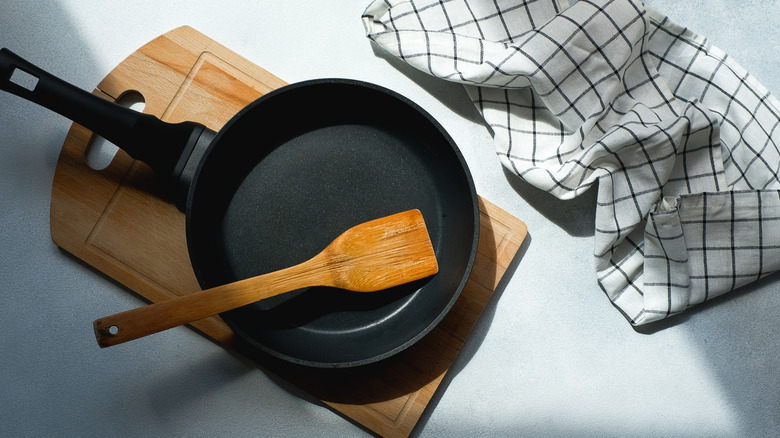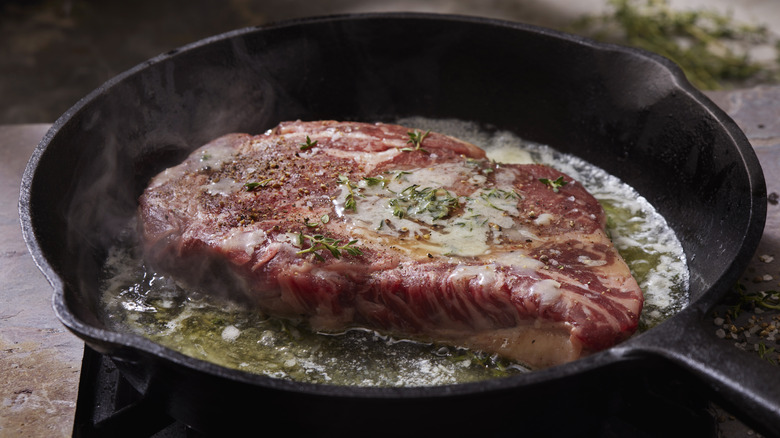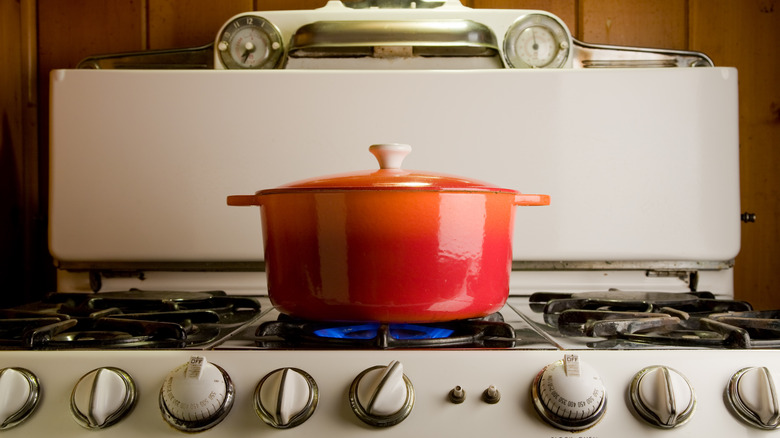The Common Cast Iron Myth You Shouldn't Fall For
Ask anyone who regularly uses cast iron, and there's a good chance they'll say it's one of their must-have tools in the kitchen. Those who love cast iron really love this ancient invention; and when we say it's ancient, we're not kidding. Archaeologists have dated this type of cookware to at least 3rd century China, and more than 1,800 years later, it's still going strong. You've probably heard all kinds of rave reviews about them, from their longevity and durability to the fact that they're pretty great at distributing heat evenly, which can make or break some dishes. Except, that last part? It's not the least bit true.
Cast iron is so widely lauded for even heat distribution that it's one of those things that we just kind of take for granted, but the truth is the precise opposite: It's terrible at evenly distributing heat. How is that even possible? The short version is that because it's so good at holding onto heat due to a number of factors, they give the appearance of perfectly distributing the even kind of heat that you need to cook something like, say, a steak. With that in mind, let's take a look at what's going on here — and what you'll need to do to get the most out of your cast iron pan.
Cast iron distributes heat in a wildly uneven way
If you're having difficulty mastering the use of cast iron and you're cooking with this oft-repeated myth tucked firmly in your chef's hat, you could be sabotaging your efforts. Just how badly cast iron conducts heat was documented in an experiment by Todd Oppenheimer, executive director of The Craftsmanship Initiative and the editor and publisher of Craftsmanship Magazine.
When he measured the temperature and heat retention abilities of several different types of pans, he found that when the cast iron was heated to 375 degrees Fahrenheit in the center, the edges remained between 250 and 275 degrees Fahrenheit. That's not just a vast temperature difference, but he added that throughout the experiment, the cast iron never reached a point where it was an entirely even temperature. That's the exact opposite of what we're always told about cast iron and undoubtedly a bit of a mind-blown moment.
When the cast iron pan is over a gas flame, for instance, it will form hot spots around the heat source. This is particularly noticeable if you're using a small burner, which will result in even more wildly uneven heating on a large pan. If you're counting on cast iron's often-lauded but completely mythical heat distribution properties to do the hard work, you're going to be disappointed. Fortunately, there's an easy fix.
Preheat your cast iron pans
Here's another strange tidbit: If you put that supposedly indestructible cast iron pan on a direct heat source and raise the heat too quickly, it's entirely possible that the tendency to form hot spots can happen so quickly that it can warp the pan. That's why it's important to preheat cast iron and to take your time: You'll end up with a pot (or pan) that's heated evenly and can sear that steak to perfection.
There are a few different ways to preheat cast iron, and if you're using the stovetop, that's completely acceptable, but it's also absolutely hands-on. Use a low heat, and keep moving the pan to prevent those hot spots from developing. Since cast iron retains heat, you'll be able to move it around to encourage even heating because it's just not going to happen on its own. Alternatively, you can pop it in the oven and let it slowly warm there while you're prepping whatever you're making.
Preheating cast iron is key, whether you're looking to cook a steak or bake a pie. In professional kitchens, chefs using cast iron pots and pans often keep multiples preheated and ready to go, and maintaining temperature is a delicate balancing act. The good news is that once your cast iron is preheated thoroughly and evenly, it'll stay that way for a while. So be sure to take proper precautions when handling it, and remember that patience is key.


